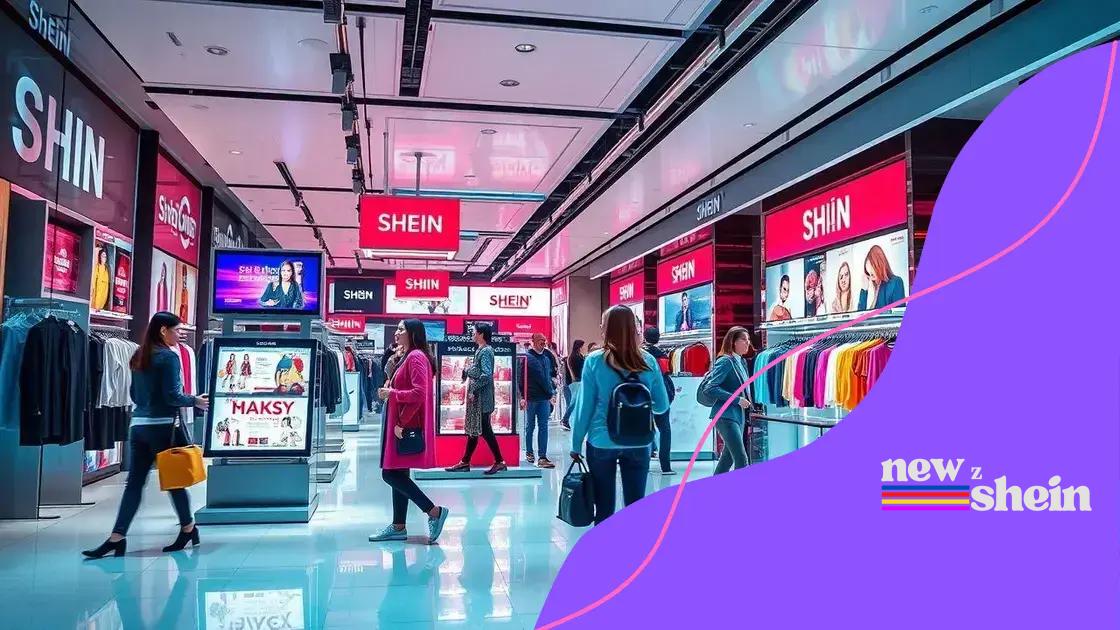Shein’s role in disrupting traditional retail economics

Shein’s role in disrupting traditional retail economics lies in its fast fashion model that prioritizes rapid production, affordable pricing, and data-driven consumer engagement, compelling traditional retailers to adapt swiftly to changing market dynamics.
Shein’s role in disrupting traditional retail economics is a fascinating topic, one that many may not fully grasp. How has this fast fashion giant changed the way we think about shopping and pricing? Let’s dive in.
Understanding Shein’s business model
Understanding Shein’s business model is essential to grasp how it revolutionized the retail landscape. This fast fashion retailer has successfully combined online shopping with rapid production cycles, providing trendy clothing at affordable prices. With a keen eye on consumer behavior, Shein adapts its inventory frequently, catering to the latest fashion trends.
Key Aspects of Shein’s Model
One of the most notable elements of Shein’s business approach is its heavy reliance on data analytics. By analyzing consumer trends and preferences, the brand can quickly pivot its offerings. This ensures that popular items are restocked while less successful designs are phased out.
Fast Production Cycle
Another critical aspect is Shein’s fast production cycle. Unlike traditional retailers that release collections seasonally, Shein introduces new styles multiple times weekly. This strategy keeps the product lineup fresh and encourages customers to return regularly.
- Rapid design and production process
- Frequent inventory updates
- Limited quantities of products to create urgency
Shein’s ability to maintain low prices while delivering new styles quickly can be largely attributed to its strong relationships with manufacturers. By outsourcing production to various locations, Shein is able to adapt and scale based on demand. This flexibility is a game changer in the retail sector.
Moreover, Shein leverages social media platforms and influencer partnerships to amplify its reach. By engaging with customers directly through platforms like Instagram and TikTok, Shein is not just selling products; it’s building a community. This approach also fuels the brand’s visibility and creates a sense of urgency to shop before popular items sell out.
The Role of User Engagement
User engagement plays a pivotal role in shaping Shein’s offerings. The brand encourages feedback and interaction through reviews and social sharing. This data gives Shein insight into what consumers are looking for and helps drive future product development.
- Active customer feedback mechanisms
- Social media promotion strategies
- Integration of user-generated content
In conclusion, understanding Shein’s business model reveals it’s more than just a retailer; it’s a phenomenon. Through its innovative use of technology, adaptability, and strong customer engagement, Shein has disrupted the traditional retail economy.
The impact of fast fashion on pricing strategies
The impact of fast fashion on pricing strategies is profound and multifaceted. Fast fashion has changed how consumers view the cost of clothing, creating a culture of immediacy and low prices. This shift leads to an ever-increasing demand for new trends at affordable prices.
Dynamic Pricing Models
One notable effect of fast fashion is the introduction of dynamic pricing models. Retailers constantly adjust prices based on various factors like demand, inventory levels, and competitor pricing. This flexibility allows brands to remain competitive while maximizing profit margins.
- Real-time pricing adjustments
- Promotional strategies to boost sales
- Clearance pricing for obsolete stock
Moreover, fast fashion influences perception. With brands like Shein, shoppers often expect to find trendy items at rock-bottom prices. This expectation can lead to a devaluation of clothing as consumers may no longer view garments as lasting investments.
Consumer Behavior Shifts
As pricing strategies evolve, consumer behavior shifts significantly. Shoppers gravitate towards brands offering low prices and quick turnover of styles. Many prefer the instant gratification of purchasing new items frequently rather than investing in higher-quality, higher-priced apparel. This mentality fosters a cycle of overconsumption, where consumers buy more than they need.
- Increased frequency of purchases
- Preference for low-cost items
- Reduced loyalty to individual brands
Furthermore, fast fashion retailers often utilize sales and discounts to attract consumers. Limited-time offers create urgency, prompting shoppers to buy immediately. This strategy not only drives sales but also results in fluctuating pricing that can confuse consumers. The constant sales can skew customer perceptions of value and quality.
Ultimately, the impact of fast fashion on pricing strategies cannot be overlooked. It has created a landscape where low prices reign supreme, and consumer behavior evolves rapidly, reflecting the changing dynamics of the retail market.
Consumer behavior shifts in online shopping

Consumer behavior shifts in online shopping have been significant in recent years, especially with the rise of fast fashion. As more people turn to online stores like Shein, the way they shop has changed dramatically. Shoppers are now looking for quick, convenient, and trendy options at their fingertips.
Convenience and Accessibility
One major change is the importance of convenience. Online shopping allows consumers to browse and buy products without leaving home. This ease encourages more frequent shopping. It’s easy to see how the click of a button can lead to multiple purchases in one session.
- Increased use of mobile devices
- 24/7 access to online stores
- Instant gratification through fast shipping
Additionally, the accessibility of social media platforms has transformed how consumers discover new products. Influencer marketing plays a huge role in shaping trends and driving purchases. When shoppers see their favorite influencers wearing certain styles, they are more likely to buy those items online.
Shifting Attitudes Toward Value
As consumers become accustomed to fast fashion, their perception of value also shifts. Low prices lead to higher purchase frequencies, but they may also challenge the idea of quality. Many shoppers now expect to pay less for trend-driven clothing, often abandoning traditional qualities like durability.
- Preference for affordable, trendy items
- Reduced focus on long-lasting clothing
- Increased willingness to buy ‘throwaway fashion’
Moreover, the variety available online encourages shoppers to explore more than ever before. With just a few clicks, customers can access numerous brands and styles, often leading to impulse buys. The endless scrolling through options encourages a browsing mindset, changing how purchases are made.
A sense of urgency is often created through marketing tactics like flash sales or limited-time offers, pushing consumers to make quicker decisions. This sense of urgency can lead to spontaneous purchases, reflecting a shift in how consumers approach their shopping habits.
Challenges faced by traditional retailers
Challenges faced by traditional retailers have grown significantly in the wake of fast fashion’s rise. These retailers are now navigating a landscape that demands quicker responses to consumer trends and preferences. Many traditional businesses struggle to adapt to the rapid pace set by brands like Shein.
Adapting to Consumer Expectations
One of the biggest hurdles is adapting to changing consumer expectations. Shoppers now expect immediate gratification. This trend pressures retailers to shorten their supply chains and deliver products faster. Consumers are accustomed to the quick turnaround times of online fast fashion brands, which can leave traditional stores at a disadvantage.
- Longer production times
- Stock management issues
- Difficulty in responding to trends
Additionally, the need to compete on price is challenging for traditional retailers. Many struggle to keep prices low due to higher overhead costs. This discrepancy can lead to a decline in sales as consumers flock to cheaper alternatives offered by fast fashion brands.
The Impact of E-commerce
The shift toward e-commerce has added another layer of complexity. As more consumers shop online, traditional retailers must invest in their online platforms to remain relevant. Many lack the digital presence required to effectively attract and retain customers. Without a strong strategy for online sales, retailers risk losing their customer base.
- Costs of developing online infrastructure
- Challenges in digital marketing
- Need for effective logistics solutions
Moreover, retaining customer loyalty has become increasingly difficult. In a market where consumers have countless options, traditional retailers must work hard to differentiate themselves. They need to provide unique experiences or reliable customer service to combat the allure of fast fashion’s constant novelty.
Lastly, sustainability concerns are pressing on traditional retailers to adapt their practices. As consumers become more environmentally conscious, they expect brands to adhere to ethical standards. This challenge requires traditional retailers to rethink their sourcing strategies and production methods, often at a higher cost.
Future trends in retail economics inspired by Shein
Future trends in retail economics inspired by Shein are likely to reshape the industry in exciting ways. As fast fashion continues to evolve, traditional retailers will need to adapt their strategies to stay competitive. One of the most important trends is the increasing integration of technology in retail.
Emphasis on Data Analytics
Data analytics will play a crucial role in shaping future retail strategies. Brands like Shein use consumer data to predict trends and tailor their offerings. This means that retail companies must invest in robust data analytics tools to better understand customer preferences and optimize inventory management.
- Personalized shopping experiences
- Real-time inventory tracking
- Targeted marketing campaigns
Additionally, as shopping habits shift online, retailers are likely to enhance their digital platforms. E-commerce will become more dynamic and user-friendly, allowing consumers to shop seamlessly across devices. The user interface and experience will be critical to attract and retain customers.
Sustainability Focus
A growing trend will be an increased focus on sustainability and ethical practices. As consumers become more environmentally aware, they will expect brands to prioritize eco-friendly materials and production methods. This shift will challenge retailers to adopt more sustainable practices in their supply chains.
- Use of organic and recycled materials
- Transparency in sourcing and manufacturing
- Promotion of sustainable consumption
Moreover, the concept of circular fashion will gain traction. This involves promoting recycling, upcycling, and resale of clothing. Retailers may adopt strategies that encourage customers to return used garments for discounts on future purchases, creating a more sustainable ecosystem.
Another trend will be the rise of collaborations between fast fashion retailers and established luxury brands. These partnerships can attract a broader audience, offering more exclusive products while maintaining an affordable price point. This strategy of blending luxury with fast fashion could lead to new market opportunities.
Ultimately, the ongoing influence of Shein on the retail landscape signifies that adaptability and innovation will be essential for success. Retailers that embrace these trends will thrive in the changing environment.
FAQ – Frequently Asked Questions about Shein’s Impact on Retail Economics
How has Shein changed consumer shopping behaviors?
Shein has introduced rapid access to trendy styles at low prices, encouraging consumers to shop more frequently and expect quicker deliveries.
What challenges do traditional retailers face due to fast fashion?
Traditional retailers struggle with longer production times, higher costs, and the need to quickly adapt to changing consumer preferences.
How is technology influencing the retail landscape?
Technology, particularly data analytics, is becoming essential for retailers to understand consumer trends and optimize their inventory management.
What role does sustainability play in the future of retail?
As consumers become more environmentally conscious, retailers are expected to adopt sustainable practices and promote eco-friendly products to meet these demands.





